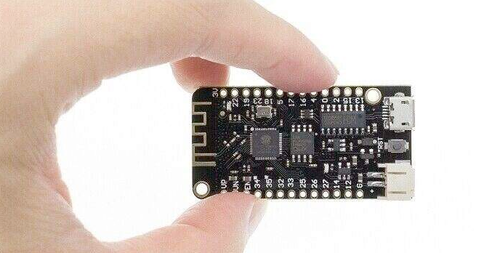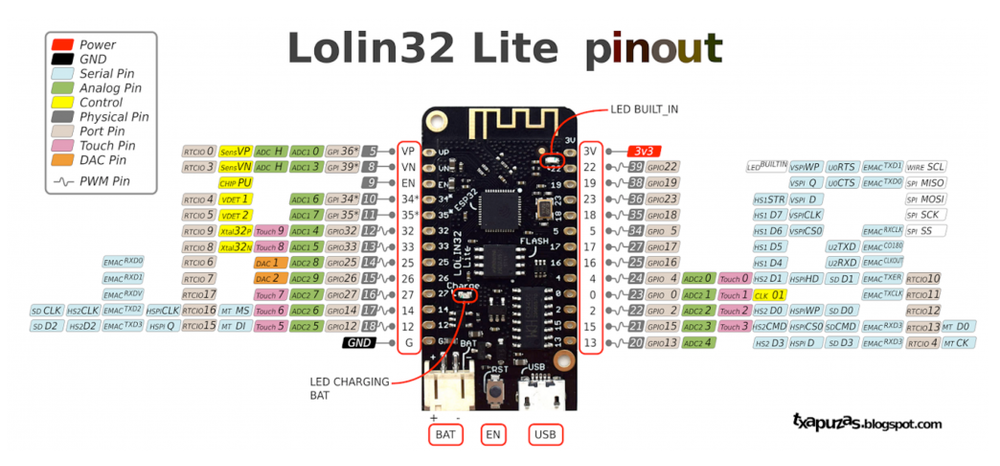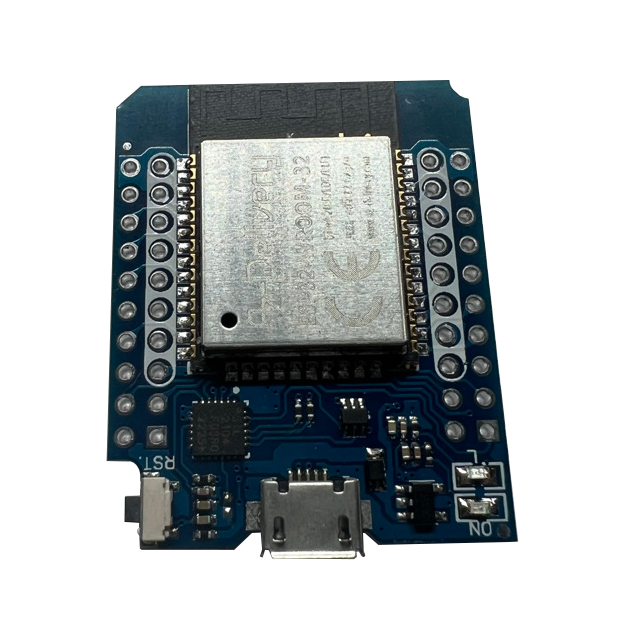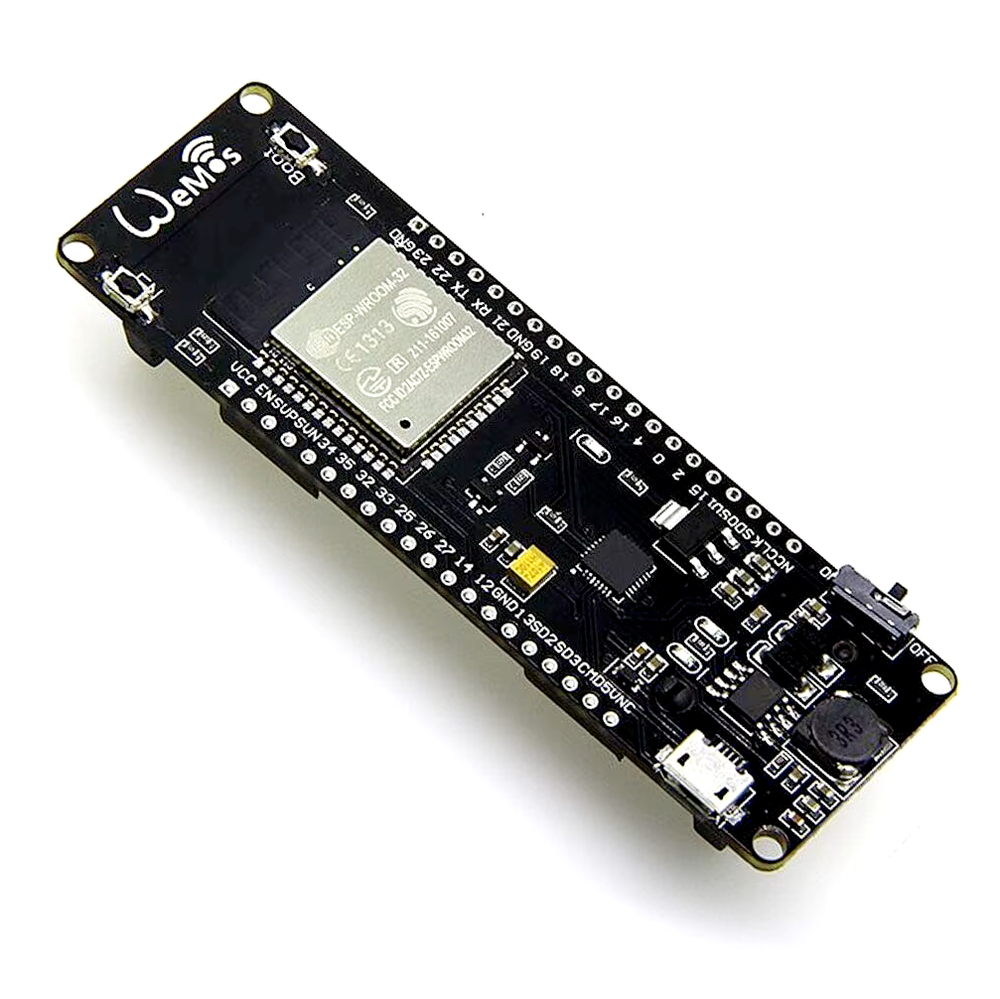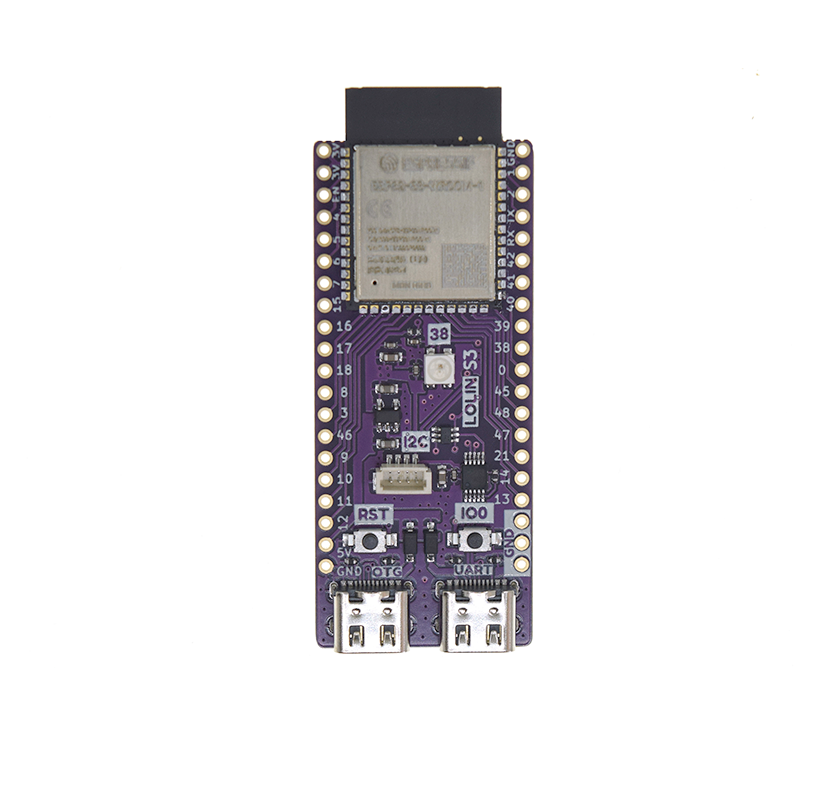WEMOS LOLIN32 Lite Development Board
Code name: LOLIN32_LITE
WEMOS LOLIN32 Lite development board is based on esp32 microcontroller and uses xtensa architecture. This board has a maximum CPU frequency of 240 MHz and a flash size of 4MB.
About WEMOS LOLIN32 Lite
The WEMOS LOLIN32 Lite squeezes Espressif’s dual-core ESP32-WROOM-32 module into a slim 57 × 25 mm board that still accepts the classic LOLIN/D1-mini shield ecosystem. It ships with 4 MB of flash, runs up to 240 MHz, and offers both Wi-Fi 802.11 b/g/n and Bluetooth 4.2 (BR/EDR + BLE) for rock-solid wireless connectivity. 📡
A low-cost CH340C USB-to-UART bridge handles programming and serial debugging via the Micro-USB port and supports auto-reset/boot so you can flash sketches without pushing buttons. :contentReference
Onboard power management is Li-Po ready: a TP4054 charger (≈ 500 mA) and a PH-2 battery connector (BAT) let you run projects untethered while the board trickle-charges whenever USB is present. ⚡️
Convenience extras include a RESET push-button, a BOOT (IO0) button for manual download-mode entry, and a bright blue on-board LED on GPIO 5 for quick status indication.
With 22 GPIOs (all PWM-capable), 12-bit ADCs, dual 8-bit DACs, 10 capacitive-touch pads, plus I²C, SPI, UART, SD-card, and RTC IO support, the LOLIN32 Lite punches far above its weight for battery-powered IoT nodes, wearables, or compact sensor gateways. ⚙️
Where to Buy



Prices are subject to change. We earn from qualifying purchases as an Amazon Associate.
Technical Specifications
🔌 USB
🛰️ Connectivity
🧠 Microcontroller
✨ Features
- 40 digital IO pins
- 16 external interrupt pins
- 16 analog input pins
- 18 PWM pins
WEMOS LOLIN32 Lite Pinout
The LOLIN32 Lite pinout fans out 26 ESP32 GPIOs on two rows, mirroring the original D1-mini shield headers for easy stacking.
Power rails: use USB 5V (or VIN) as input, the regulated 3V3 pin for logic-level peripherals, and the dedicated BAT pin for a single-cell Li-Po. Multiple GND pads provide solid returns.
Serial: U0_TX (GPIO1) and U0_RX (GPIO3) connect to the CH340C for programming/logging. Need more ports? U2_TX (GPIO17) and U2_RX (GPIO16) are free for GPS or RS-485 transceivers.
I²C defaults to SDA (GPIO21) and SCL (GPIO22), broken out on the shield D2/D1 lines—but any spare GPIO can be reassigned.
SPI: the primary VSPI bus (best for OLEDs, SD adapters, radios) maps to MOSI (GPIO23), MISO (GPIO19), SCK (GPIO18), and CS (GPIO5). A secondary HSPI bus lives on GPIO12-15 when you need a second device.
Analog & touch: Eight ADC1 channels (GPIO32-GPIO39) work even with Wi-Fi on. Extra ADC2 pads (GPIO0, 2, 4, 12-15, 25-27) share RF hardware. Dual 8-bit DAC outputs are on GPIO25 and GPIO26. Ten pads double as capacitive-touch inputs—great for touch keys or wake-up gestures.
Every GPIO can generate high-resolution PWM (up to ≈40 kHz). Remember the boot-strap pins—GPIO0, GPIO2, and GPIO15—must sit HIGH (with proper pull-ups) on reset for a normal boot.
With battery charging, robust power rails, and a shield-friendly layout, the LOLIN32 Lite pinout makes it effortless to go from breadboard prototype to compact, battery-powered product.
✅ Safe Pins to Use
For general GPIO usage, these are the safest and most flexible choices:
Why Are These Pins Safe?
- Not involved in bootstrapping → No impact on device boot mode or system startup
- Not linked to flash memory or PSRAM → Won't interfere with storage or memory access
- Not dedicated to USB or JTAG → Free for general use without affecting debugging
- No special hardware connections → Freely assignable without internal conflicts
⚠️ Pins to Avoid or Use with Caution
Some pins are reserved for critical functions like bootstrapping, JTAG debugging, USB communication, and flash memory operations. Misusing these pins may lead to boot failures, programming issues, USB conflicts, or disruptions in flash storage.
Critical Pin Categories:
- 🛠️ Strapping Pins: Control boot behavior and flash voltage selection
- 🔗 JTAG Debugging Pins: Required for low-level debugging
- 🔌 USB Communication Pins: Used for USB Serial/JTAG communication
- ⚡ Flash Memory & SPI Pins: Connected to SPI flash memory and PSRAM
- 📡 UART Serial Communication Pins: Used for debugging and firmware uploads
| PIN | Label | Reason | Function |
|---|---|---|---|
| IO0 | GPIO0 | Must be HIGH during boot for normal startup; if held LOW on reset, forces flash programming mode. | 🛠️ Strapping |
| IO2 | GPIO2 | If driven HIGH on reset (while IO0 is LOW), selects an unsupported SDIO boot mode, causing boot failure. | 🛠️ Strapping |
| IO4 | GPIO4 | Sampled at reset for boot config; should not be driven at boot (affects boot mode timing). | 🛠️ Strapping |
| IO5 | GPIO5 | Must be HIGH during boot; if pulled LOW at reset, alters SDIO slave timing and may prevent normal boot. | 🛠️ Strapping |
| IO12 | MTDI (GPIO12) | Keep LOW during boot (internal PD); pulling HIGH at reset selects 1.8V flash mode, causing flash brownout if 3.3V flash is used. | 🛠️ Strapping |
WEMOS LOLIN32 Lite Pin Mappings
This development board provides 40 digital IO pins, out of which 16 can be used as external interrupt pins , 16 as analog input pins and 18 pins have Pulse-Width Modulation (PWM) .
| Pin | Function | ESP Pin | Input/Output | Description |
|---|---|---|---|---|
| 1 | 5V | 5V | POWER INPUT | 5V power input for the board |
| 2 | GND | GND | POWER GROUNT | Ground connection |
| 3 | 3V3 | 3.3V | POWER OUTPUT | 3.3V power output |
| 5 | IO0 | GPIO0 | BIDIRECTIONAL | GPIO, ADC |
| 6 | IO2 | GPIO2 | BIDIRECTIONAL | GPIO, ADC |
| 7 | IO4 | GPIO4 | BIDIRECTIONAL | GPIO, ADC |
| 8 | IO5 | GPIO5 | BIDIRECTIONAL | GPIO |
| 9 | IO12 | GPIO12 | BIDIRECTIONAL | GPIO, ADC |
| 10 | IO13 | GPIO13 | BIDIRECTIONAL | GPIO, ADC |
| 11 | IO14 | GPIO14 | BIDIRECTIONAL | GPIO, ADC |
| 12 | IO15 | GPIO15 | BIDIRECTIONAL | GPIO |
| 13 | IO16 | GPIO16 | BIDIRECTIONAL | GPIO |
| 14 | IO17 | GPIO17 | BIDIRECTIONAL | GPIO |
| 15 | IO18 | GPIO18 | BIDIRECTIONAL | GPIO |
| 16 | IO19 | GPIO19 | BIDIRECTIONAL | GPIO |
| 17 | IO22 | GPIO22 | BIDIRECTIONAL | GPIO |
| 18 | IO23 | GPIO23 | BIDIRECTIONAL | GPIO |
| 19 | IO25 | GPIO25 | BIDIRECTIONAL | GPIO, ADC |
| 20 | IO26 | GPIO26 | BIDIRECTIONAL | GPIO, ADC |
| 21 | IO27 | GPIO27 | BIDIRECTIONAL | GPIO, ADC |
| 22 | IO32 | GPIO32 | BIDIRECTIONAL | GPIO, ADC |
| 23 | IO33 | GPIO33 | BIDIRECTIONAL | GPIO, ADC |
| 24 | IO34 | GPIO34 | BIDIRECTIONAL | GPIO, ADC |
| 25 | IO35 | GPIO35 | BIDIRECTIONAL | GPIO, ADC |
| 26 | IO36 | GPIO36 | BIDIRECTIONAL | GPIO, ADC |
| 27 | IO39 | GPIO39 | BIDIRECTIONAL | GPIO, ADC |
WEMOS LOLIN32 Lite Pins Mapping Arduino IDE
Below you can find the WEMOS LOLIN32 Lite pinout. This development board provides 40 digital IO pins, out of which 16 can be used as external interrupt pins, 16 as analog input pins and 18 pins have Pulse-Width Modulation (PWM).
| Pin | Analog | Touch | PWM | Other |
|---|---|---|---|---|
| 0 | A11 | T1 | ||
| 1 | PWM | TX | ||
| 2 | A12 | T2 | PWM | |
| 3 | PWM | RX | ||
| 4 | A10 | T0 | PWM | |
| 5 | PWM | SS | ||
| 12 | A15 | T5 | PWM | |
| 13 | A14 | T4 | PWM | |
| 14 | A16 | T6 | PWM | |
| 15 | A13 | T3 | PWM | |
| 18 | PWM | SCK | ||
| 19 | PWM | SDA MISO | ||
| 22 | PWM | LED_BUILTIN | ||
| 23 | PWM | SCL MOSI | ||
| 25 | A18 | PWM | DAC1 | |
| 26 | A19 | PWM | DAC2 | |
| 27 | A17 | T7 | PWM | |
| 32 | A4 | T9 | PWM | |
| 33 | A5 | T8 | PWM | |
| 34 | A6 | |||
| 35 | A7 | |||
| 36 | A0 | |||
| 39 | A3 |
Default Tools
| Bootloader tool | esptool_py |
| Uploader tool | esptool_py |
| Network uploader tool | esp_ota |
| Bootloader address | 0x1000 |
| Flash mode | dio |
| Boot mode | dio |
| Maximum upload size | 1280 Kb (1310720 B) |
| Maximum data size | 320 Kb (327680 B) |
The WEMOS LOLIN32 Lite development board by default uses esptool_py uploader tool, esp_ota network uploader tool for Over-the-air (OTA) uploads and esptool_py bootloader tool. The bootloader starts at address "0x1000". Flash mode and boot mode for WEMOS LOLIN32 Lite development board by default is dio and dio respectively.


